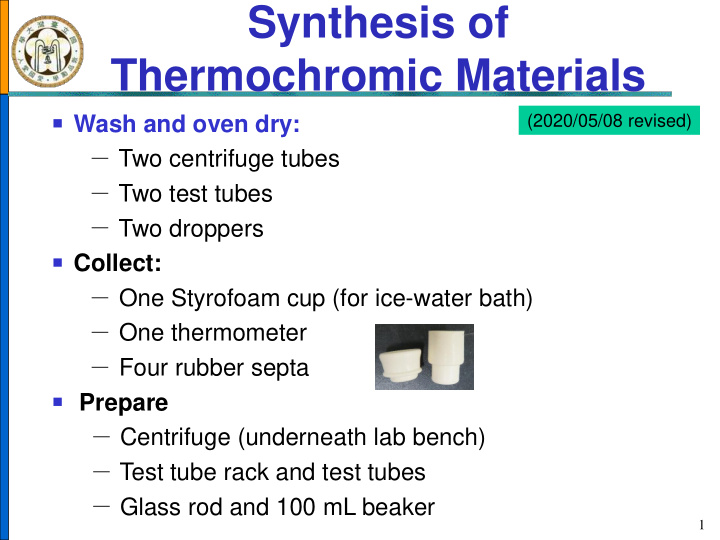



Synthesis of Thermochromic Materials Wash and oven dry: (2020/05/08 revised) - Two centrifuge tubes - Two test tubes - Two droppers Collect: - One Styrofoam cup (for ice-water bath) - One thermometer - Four rubber septa Prepare - Centrifuge (underneath lab bench) - Test tube rack and test tubes - Glass rod and 100 mL beaker 1
Objective Objective To synthesize a thermochromic solid from diethylamine hydrochloride and copper(II) chloride 2(CH 3 CH 2 ) 2 NH HCl + CuCl 2 [(CH 3 CH 2 ) 2 NH 2 ] 2 [CuCl 4 ] Thermochromic materials – Substance that changes color with temperature – Divided into two types: continuous and discontinuous thermochromic – According to the crystal field theory, changes in geometry, ligands, or coordination number in the coordination sphere may cause the color change 2
Introduction [(CH 3 CH 2 ) 2 NH 2 ] 2 [CuCl 4 ] – Bright green at room temperature – Yellow color when temperature increases The color change is caused by a change in the geometry of the complex ion, [CuCl 4 ] 2- [CuCl 4 ] 2- Cu 2+ Cu 2+ High temp. Low temp. Distorted tetrahedron, yellow Square planar, green 3
Step 1 Prepare Reactants and React Wash & oven dry: • Centrifuge tubes • Glass dropper • Test tubes • 0.002 mol (0.22 g) • 0.001 mol (0.13 g) diethylamine hydrochloride *All glassware must be dried CuCl 2 • Placed chemicals in a centrifuge tube • Add 1 mL isopropyl alcohol, iPA • Stir to dissolve and produce product • Place in an ice-water bath to crystallize completely 4
Step 2 Wash and Collect the Product [(CH 3 CH 2 ) 2 NH 2 ] 2 [CuCl 4 ] Collect product Wash the product Rinse with ether Add 1 mL ether to Centrifuge and decant the several times until rinse the final product supernatant, iPA the supernatant is in tube thoroughly Add 1 mL ice-cooled ether colorless Settle in ice-water bath Stir and mix well to wash for 1 min. and decant the product the ether layer Centrifuge and decant the Place the tube in a ether layer warm water bath ca. 40 o C to evaporate residual ether 5
Step 3 Examine the Thermochromic Temperature Fix the sample tube to the thermometer as shown Place the test tube and ↔ thermometer in a cold water bath in a 100 mL beaker Heat the water bath slowly to observe the color varied with Place the thermometer in temperature the center of water bath Replace into ice-water bath to check if the color change Thermochromic temp.? is reversible Reversible? 6
Notice Condensed report Both reactants are hygroscopic; put the cap back after use Cap the tube with rubber septum to reduce the evaporation of organic solvent Cool the product in centrifuge tube after each rinsing to reduce solubility of product During centrifuge, centrifuge tubes should be placed in opposite sides to keep balanced Evaporate the ether solvent in the fume hood Collect all the organic solvent in one test tube, then pour into organic waste bottle Use small portions of water to dissolve the product and discard into the heavy metal recycling bin 7
T8 - Centrifugation T8 Video on YouTube (Click) Check the casing inside the machine is intact. If corrosion causes holes in casing or there is an unknown object inside, clean or replace the casing. Use centrifuge tubes in centrifugation, do not use test tubes. Centrifuge tubes should be placed in opposite sides to keep balancing. The lid should be closed during use; the centrifuge should be started from slow rate to check if there is any malfunction, then the speed can be increased. If there are unusual sounds or shaking in the centrifuge, the power should be turned off first in order to fix up. There must be at least one person look after the centrifuge when in use. Centrifuge for approx. 1~2 min , open lid when the centrifuge has 8 completely stopped.
Recommend
More recommend